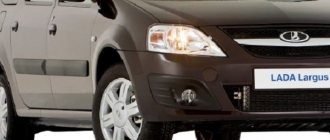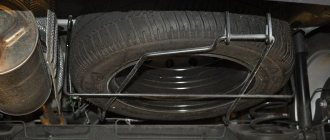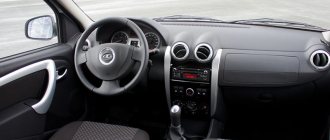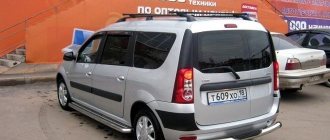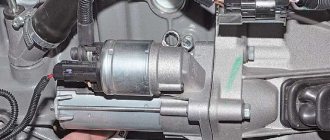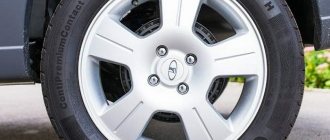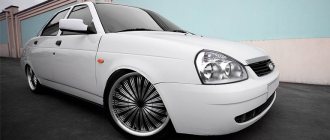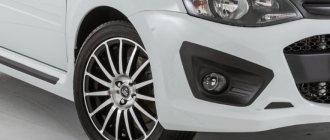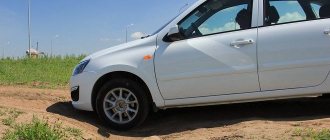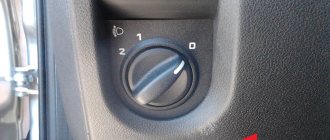Tires directly affect fuel consumption, vehicle cross-country ability, its behavior on the road, and noise level. The appearance of the vehicle also depends on the tires.
AvtoVAZ recommends a certain wheel size for Lada Largus. Let's consider the parameters allowed by the manufacturer and study possible variations. Let's get acquainted with the top 5 winter and summer tires (according to owner reviews).
Lada Largus is represented by three models (Largus R90, F90, Cross). Options with 7 or 5 seats are produced (except for the F90 cargo vehicle). The basic requirements for tires and wheels differ only for the Lada Largus CROSS. Parameters important when choosing wheels are indicated in the user manual. The recommended index of load capacity and speed, the standard air pressure are also set in the instructions.
| Model | Size, load capacity index | Center diameter wheel holes (DIA) | Radius between holes (PCD) | Number of nuts, pcs. | Wheel width, inches | Disc offset (ET) |
| R90 | 185/65R 15 88 H | 60,1 | 100 | 4 | 6J | 50 |
| F90 | 185/65R 15 92 H | 60,1 | 100 | 4 | 6J | 50 |
| CROSS | 205/55R 16 91 H | 60,1 | 100 | 4 | 6J | 50 |
Owners consider the categories of acceptable sizes. One of the reasons is the range of prices; manufacturers have better options among non-standard tires. Sometimes rubber remains from an old car. Some people think that the larger the wheel, the better. Let's learn how to choose safe wheels.
What non-standard sizes can be supplied?
Buy tires based on the full diameter of the wheel. It shouldn't be too different from the standard one.
Standard sizes allowed for installation.
| Model | Size, load capacity index | Center diameter wheel holes (DIA) | Radius between holes (PCD) | Number of nuts, pcs. | Wheel width, inches | Disc offset (ET) |
| R90 | 185/65R 15 88 H | 60,1 | 100 | 4 | 6J | 50 |
| F90 | 185/65R 15 92 H | 60,1 | 100 | 4 | 6J | 50 |
| CROSS | 205/55R 16 91 H | 60,1 | 100 | 4 | 5 ½, 6, 6 ½ J | 50 |
Attention. Replacing recommended sizes with acceptable ones will affect a number of characteristics. The dependence is shown in the table.
| Parameter | Increasing tire width | Increasing rim width |
| Keeping the car on the road | will improve | will improve |
| Accuracy of maintaining a given direction of movement | will improve | will improve |
| Road grip coefficient | will increase on dry roads | does not affect |
| Resistance to aquaplaning effect | will get worse | without changes |
| Traffic noise | will intensify | does not affect |
| Feelings when driving on rough roads | more comfortable | does not affect |
| Fuel consumption | will increase | will increase |
| Tire wear time | will speed up | without changes |
Be sure to calculate the load capacity index. Depending on the model, 88 (560 kg), 92 (630 kg) and 91 (615 kg) are allowed. The speed index is indicated next to the load capacity. T – up to 190 km/h, H – up to 210, V – up to 240.
An approximate formula will come in handy. Calculate the mass of the car, the weight of all possible passengers and cargo. Divide by 4 (wheels). Add a little extra.
Example: 1330 + 350 (passengers) + 170 (cargo) = 1850 / 4 = 462.5 kg + 40 = 502.5. In this case, a coefficient of 88 is acceptable. For summer tires, you will most likely need more.
Important! Installing large wheels can lead to incorrect operation of the ABS and electronic dynamic stabilization system of the vehicle.
The lighter the tires and wheels, the faster the vehicle accelerates. Thus, a car will accelerate to 100 km/h 0.2 seconds faster if the wheel weight is 2 kg less.
It is necessary to pay attention to the production date of the tire. Indicated on the side as a four-digit code. Explanation: the first two digits are the week of issue, the second are the year. The seller is obliged to sell tires within 5 years from the date of production (subject to proper storage).
Lada Largus Cross
From the factory, the off-road version of the Largus is equipped with R16 wheels with the following parameters:
- disc width - 6J;
- drilling - 4×100;
- departure - ET 50;
- centering hole - DIA 60.1.
Tires used are Continental Premium Contact with dimensions 205/55 R16.
When installing tires or wheels that differ in parameters
from the recommended ones, you can:
- be refused warranty repair of the chassis;
- be stopped by a traffic police inspector, who has the right to draw up a report on the car’s non-compliance with the requirements of the Technical Regulations;
- fail to pass technical inspection.
Buy wheel rims for Lada Largus at the lowest prices
possible with us.
Let us remind you that other instructions for modifying a station wagon and a van can be found in this category or by content.
Keywords: Lada Largus tires | Lada Largus wheels | Lada Largus Cross
2 0 0 0 0 0
Share on social networks:
What is the tire pressure
The tire pressure level is specified in the manufacturer's instructions.
| Model | Front tire pressure, kgf/cm² | Rear tire pressure, kgf/cm² |
| R90 | 2,4 | 2,6 |
| F90 | 2,4 | 3,0 |
| CROSS | 2,4 | 2,6 |
Constant monitoring of this parameter is necessary. Fluctuations to a lesser or greater extent affect the behavior of the car, efficiency, and driving safety. Let's look at the relationship more specifically.
Pressure higher than specified:
- the tire is harder, the comfort of movement decreases;
- the risk of damaging the wheel when hitting a stone or hole increases;
- grip on the road deteriorates;
- braking distance increases;
- the tread pattern wears unevenly;
- wheels rotate easier;
- machine stability improves.
Pressure below normal:
- fuel consumption increases;
- rubber wear increases (due to an increase in the contact patch area);
- car steering accuracy deteriorates;
- stability on the road surface decreases (due to changes in the angle of inclination);
- the risk of skidding increases.
Wheel sizes for Largus
It turns out that not everyone knows the size of the disks for our car, and what the marking numbers on the stamped disk mean:
Lada Largus/Renault 6×15 PCD 4x100 ET50 DIA60.1
, Where
6 x 15 - seat width of the tire in inches, solid disk (not split), disk diameter in inches 4 x 100 - 4 mounting bolts located around a circle with a diameter of 100 mm ET50 - disk offset DIA60.1 - landing diameter on the hub. This is the hole in the middle of the disk. The hub has a cylindrical protrusion with a diameter of 60, respectively. This is for centering the disk!
Can
take a rim with a width of 5.5, 6.5 or 7, but then you need to take the same tires. In addition, this size is related to ET.
It is forbidden
take a disc
with another
PCD. It is clear that it is not possible to tighten 5 bolts into 4 holes, or 4 bolts located on a 110 mm circle will also not tighten - with any other PCD, the holes simply do not match.
Can
cook ET50. Those who like to drive or show off reduce this size with spacers or ready-made discs to change the characteristics of the car. But you need to know that in addition to increasing stability, reducing ET leads to an increase in the load on the wheel bearing. If you really like the disc, then within small limits you can still take it with another ET.
Elsewhere I found this picture and formula:
Can
take a disk
with a large
DIA, for example, 67.1, but in this case an additional part will be required. You will have to look for or make a ring that fits on your 60 mm hub, and the outside diameter of the ring will be equal to the hole in the 67.1 disk. You cannot put a disc with a lower DIA value on Largus. If you really want to and the disk has a size close to 60.1, then you can bore the central hole. Spacers can be made.
Source
Frequency of checking tire pressure
The tightness of the wheel structure is not ideal. The air gradually comes out. The reduction in pressure directly depends on the air temperature.
Monitoring must be regular. It is optimal to check your blood pressure at least twice a week. Ideal when leaving a parking lot, visiting a gas station, or performing maintenance.
The measurement should be carried out before the tires heat up (for example in the morning) in all wheels, even in the spare wheel. Checking along the way will not give accurate indicators.
The pressure in the tire should be lower than in the other wheels.
Visual assessment of the condition of tires is an irresponsible attitude towards the vehicle and safety. There is a high risk of not noticing a slight decrease or increase in pressure (0.1-0.5 atmospheres).
It must be remembered that temperature fluctuations and vehicle loading lead to changes in the indicator.
In the following situations, it is recommended to reduce the atmosphere to a level lower than the factory instructions:
- when driving on a slippery road (in winter);
- for off-road driving.
Memo on wheel and tire parameters.
The information is not new.
I reworked the original source for myself. Stock wheels: 4*100*15, ET50, CO 60.1, width 6. Stock tires: 185/65/15
Disc widths:
6.5 to 7.5 is the average optimal width, regardless of diameter. 8 and more - already requires a more careful selection of the wheel offset and tire width.
Rubber:
, The most optimal dimensions for “adequate” offset, depending on the wheel size: 15th - 195*65*15. 16th - 205*55 or 60*16 17th - 205*50 or 215*45*17. 18th - 215*40 or 205*45*18. 19th - 215*35 or 40*19. 20th - 225*30*20 or 215*35*20.
Disc offset - ET:
15th - ET from 40 to 45. 16th - ET from 40 to 45. (with 40 offset tires it is better to choose 195*60 or 55) 17th - ET from 42 to 46. 18th - from 42 to 46. 19th - from 42 to 45. 20th - from 40 to 45. The minimum offset value allows you to move the wheel out of the arch as much as possible, the maximum value allows you to recess the wheels. If on wheels from 15 to 17 there is a margin, you can not be too critical of the offset, but on sizes larger than 18 it plays the main role.
Example:
- we have wheels with tires 225*40*18 and an offset of 40. The width of the rim can be 7 or 7.5 - it doesn’t matter. As a result, such wheels will 100% rub the plastic in the area of the rear bumper when loading. There is only one way out - take 215*40*18 tires and wheels with an offset of 42 or more.
Source
How to choose the right tire diameter
The choice of tires or wheels for the Lada Largus affects not only the external design of the car, but also the behavior of the vehicle on the roads. Car manufacturers indicate acceptable dimensions. Before installing the appropriate components, you need to familiarize yourself with the basic parameters. After all, replacement of products is carried out in order to improve driving performance.
The Largus instruction manual indicates only one acceptable size - 185/65 R15. Factories install stamped wheels on Largus 15 inches. In addition to the standard size declared by the manufacturer, car enthusiasts install 14-inch tires with a dimension of 185/70 R14. Among 15-inch tires, the tires chosen for Largus are 195/65 R15; 205/60 R15, 195/60 R15 are rare.
Non-standard wheels instead of standard wheels
Sometimes owners have, for example, 14-inch stamped wheels left over from a previous car. Is it possible to install them on LADA Largus instead of the original “products”? Yes, but it will require loosening.
In such a situation, you may encounter the problem of aligning the disc with the brake caliper bracket. The fact is that the bracket sticks out in relation to the plane of contact of the disk to the hub. Moreover, if you tighten the fasteners of such a disk, it will subsequently not be able to rotate.
The same situation will happen if you install R15 wheels. They will rub against the same unfortunate bracket.
Only 16-inch ones will provide the required clearance.
If the discs have a small offset, then after installation they will provoke a change in the load applied to the wheel bearings. Also, protruding rims and tires will “throw” dirt onto the side panels of the body.
It is useful to know that a 6.5-inch disk with a 45 mm offset will touch body elements.
Largus is equipped with Magnetto Wheels
The manufacturer installs 15-inch versions on the Lada Largus, which are supplied by the Magnetto Wheels corporation. Such products have conventional parameter markings in the form: “6×15/4×100 D60.1 ET50”.
Now let's decipher it in parts:
- “6” characterizes the width of the product in inches;
- “15/4x100” - here we have: 15-inch with 4 attachment points to the hub and a distance between the centers of the holes for fasteners equal to 100 mm;
- “D60.1” denotes the diameter of the hole in - the amount of overhang, which in our case is 50 mm.
The owners claim that Logan wheels are perfect for LADA Largus. Their parameters are as follows: “5.5×14/4×100 D60.1 ET43”. To complete such wheels, you will need to purchase 185x70xR14 tires.
Increasing the width of wheels and tires
As the width of the wheel and, accordingly, the tire increases, stability and controllability improve, but fuel begins to be consumed much faster.
Wide tires help to “hold” the road better, since the grip and area of the contact patch with the asphalt is larger.
Regarding the disadvantages, we note that tires with increased width are prone to aquaplaning, which is dangerous at speeds above 50 km per hour. The Lada Largus runs the risk of drifting off the trajectory when driving through large puddles at speed. There is also increased noise and increased fuel consumption. This is why the correct size of tires and wheels is so important.
Features of wheels for the domestic model
In the technical manual, the inquisitive owner will find only one wheel option offered by the manufacturer - this is 185x65xR15. The factory installs stamped wheels with the specified dimensions. Since the Russian model Lada Largus is a “clone” of the Dacia Logan station wagon, produced since 2006, in the characteristics of the Romanian car you can find an indication of the identical wheel size.
The owners have gained experience installing 14-inch wheels. These products have the following dimensions - 185x70xR14. However, such wheel options are not very popular, and it is quite rare to see them on a car. Much more common modifications of r15 wheels - these are 15-inch wheels - are the following options:
A little less common are rims that measure 16 and even 17 inches. Among these options you can find the following standard sizes:
Well, you can’t ignore the exclusive versions with an impressive 18-inch dimensions.
In the notation, R is the radius of the tire, and the numbers are the width of the tire and the height of its profile, respectively.
Review of the best summer and winter tires
It is better to have separate sets of tires for driving in winter and summer. For driving at sub-zero temperatures, a good solution could be products from Belshina’s company – Artmotion Snow. There are no tires on it. However, this model is perfect for traveling within the city in winter. Its cost will be approximately 1,900 rubles.
Marshal I Zen KW15 will cost the buyer a little more – approximately 2,900 rubles. There are also no studs, but such tires make you feel more comfortable on the road. The maximum permissible speed on the highway is 190 km/h.
Landsail Winter Lander will be an excellent solution for drivers who practice an aggressive driving style and prefer to drive at high speed. The tires hold the road well, the H speed index allows you to move steadily at speeds of up to 210 km/h.
BF Goodrich G-FORCE WINTER2 is a typical Velcro. Despite the relatively low cost, this model boasts good grip on the road surface, regardless of its condition (rain, snow, ice). The strong sidewall makes it easy to take turns.
Goodyear UltraGrip Ice+ comes with 250 studs per wheel. The presence of steel spikes allows for excellent “holding” of the road, regardless of its condition. Even ice will not become an obstacle for the driver - a car with studded tires will take any turn perfectly.
Many owners are quite frivolous when choosing summer tires. However, good tires will make the car more controllable and stable on the road. Falken FK-452 guarantees good grip in any weather. The presence of a large number of furrows eliminates the process of aquaplaning.
BF Goodrich G-GRIP is an inexpensive and very durable tire. Many owners note its almost complete silence at any speed. Good grip on the road is ensured by the shape of the tread.
Maxxis MP10 MECOTRA allows you to reduce braking distance to a minimum. The cost of such a model is relatively low. However, at temperatures below 20 degrees Celsius, the tires begin to make noise.
Goodyear Vector 4Seasons Gen-1 allow you to comfortably drive a car of almost any weight - regardless of the number of passengers or the presence of cargo. It differs in the depth of its tread. A good choice for those who often travel on dirt roads.
Dunlop SP TOURING R1 is grippy on both dry and wet pavement. It is distinguished by its insensitivity to ruts. However, off-road it does not show its best side.
The use of recommended tires with a nominal pressure is the key to safe operation of the vehicle.
Source
